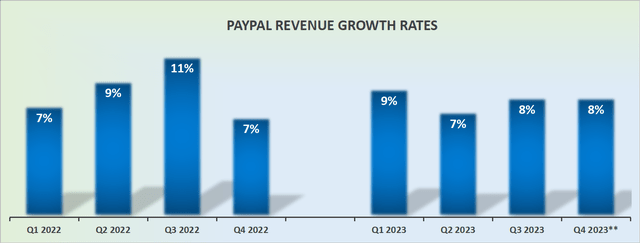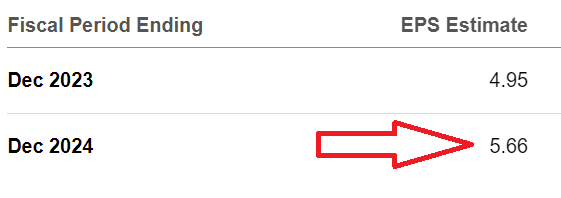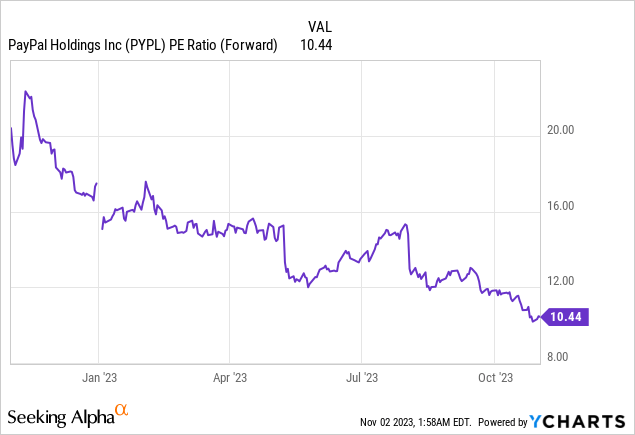Investment Thesis
PayPal (NASDAQ:PYPL) recently released a meek and lackluster earnings report. And yet, this has led to my recommendation to buy the stock. Why, you ask?
In my experience, global brands occasionally undergo a price drop, making them appealing at around 10x EPS.
Looking ahead to the next twelve months, I’m not advocating for extraordinary measures, but rather a focus on the stability of PayPal’s multiple, which I expect to remain steady, as explained below.
As I look out over the next twelve months, I’m not arguing for heroics, as you’ll see.
My only consideration is that PayPal’s multiple doesn’t compress further, which I believe it won’t, for reasons mentioned herein.
Quick Recap
As we headed into the earnings results, this is what I wrote about PayPal,
PayPal’s stock outlook is unappetizing. Grim. Uncertain. Navigating a highly competitive landscape where peers from all corners are encroaching on its turf. What can PayPal do?
Yes, PayPal stock is wound tightly, like a coil, ready to go higher. But thinking in that manner doesn’t do anybody any good. Why?
Because when you say something is tightly coiled, you are priming investors into the expectation that the stock will pop. Soon. And that’s the wrong way to think about investing. The best sort of investing is boring and slow.
The best sort of investing is when you are buying as others are capitulating. When you have no expectations. And you are willing to put in what others can’t: patience.
Therein lies the PayPal opportunity. Accordingly, here’s why I believe that paying 10x next year’s EPS for PayPal is attractive.
Having followed PayPal for a long time, I now believe is a good time to increase my confidence in this name and buy shares in this stock.
PayPal’s Near-Term Prospects
PayPal’s near-term prospects appear to be focused on driving profitable growth while managing the cost base efficiently. The company’s leadership, particularly Alex Chriss, emphasizes the need to prioritize investments in growth initiatives while also streamlining operations through automation and cost management. Despite acknowledging the challenges and areas that require further attention, the company seems determined to leverage its strong assets, including a globally recognized platform, the popularity of Venmo, and robust data capabilities, to enhance the customer experience and drive business growth. The emphasis on improving transaction profit dollar growth and expanding the acceptance of Venmo, suggests that PayPal is poised to navigate the near-term challenges and position itself for sustainable growth in the future.
Revenue Growth Rates Are Stabilizing Around High Teens
PYPL revenue growth rates
PayPal faces several near-term challenges that require immediate attention. One of the key issues highlighted is the need to focus the organization on the most impactful opportunities and prioritize essential initiatives, as the company seems to be spread too thin, leading to inefficiencies and potentially hampering overall performance. Additionally, the company acknowledges a decline in transaction profit dollar growth and has lowered its revenue outlook for the upcoming quarter, indicating a cautious approach in light of the current business environment. This cautious outlook suggests that PayPal may encounter hurdles in sustaining its profitable growth momentum, necessitating strategic adjustments to address these challenges.
More specifically, the business is likely to continue growing at around the high-single digits. So why should you invest in PayPal now?
Here’s the thing, when new management comes to a company, they’ll want to make changes. And they have to put their stamp on the company sooner rather than later.
I have no idea whether or not these changes will end up being positive or not, but I believe you’ll agree with me that changes are going to come over the next twelve months. And given where investors’ expectations are now, I believe this is a good time to buy into PayPal.
PYPL’s Multiple Has Fully Compressed
PayPal is about to make close to $5 of non-GAAP EPS. Furthermore, PayPal has approximately $11 billion of cash and equivalents, and just over $15 billion, if we include its investment portfolio. This is against its $11 billion of debt.
Accordingly, PayPal is not only capable of making about $5 billion of free cash flow per year, but it also has a very robust balance sheet. Of that, there can be little denying.
So, the problems facing PayPal are not about a lack of market share. Or even, that the business hasn’t figured out how to make free cash flows. No, the problem that PayPal faces is one of investors’ expectations.
Nonetheless, I continue to believe that PayPal will make close to $6 of EPS in 2024. Note, this is higher than analysts’ own estimates right now, see below.
SA Premium
But irrespective of me being right or analysts being closer to reality, this stock is now priced at 10x next year’s EPS.
For my thesis to work out positively, I am not expecting a re-rating of PayPal’s multiple. I’m only claiming that if PayPal’s multiple remains around 10x forward free cash flow and doesn’t compress further, this stock provides a positive risk-reward.
As further evidence that PayPal’s multiple has compressed a lot already, consider the graphic that follows.

Just twelve months ago, investors were willing to pay twice the multiple for PayPal than they pay today.
If investors were to re-rate the stock higher, even slightly, that would be icing on the cake, but that’s not necessary for my investment to deliver a positive return.
The Bottom Line
When considering PayPal’s current valuation, it becomes evident that the stock is attractively priced, particularly when factoring in its solid balance sheet and consistent free cash flow generation.
With investor expectations low and the market already reflecting a compressed multiple, there is ample room for positive sentiment to drive the stock’s performance.
As the company sets its sights on executing strategic changes, PayPal appears well-positioned to exceed current market expectations and deliver strong returns for investors in the next twelve months.
Read the full article here



